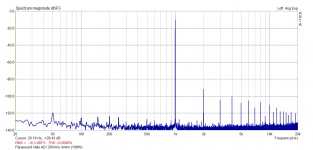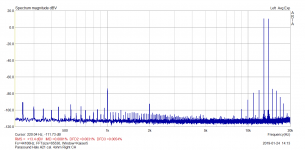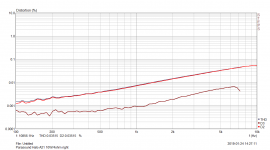Loudspeakers, because they operate open loop, SEEM to be much more important than almost any amp, static measurement for static measurement, BUT low distortion in amps is usually achieved by adding negative feedback, AND this does not seem to improve the sound much, if any. A good 'open loop' amp with modest distortion (compared to others) might sound better than a 'zero distortion' amp. That is our experience, and has been for more than 50 years.
I see what you mean Pavel 😉
Pavel trusts his double-blind tests, rather than his ears. That is why everything sounds pretty much the same to him.
I am not claiming that a Class A/B amp can't work with reactive load. I am saying that the output stage drive voltage is quite different for reactive load compared to resistive load and will contain harmonics in order to maintain constant output voltage condition.
No, it doesn't contain any more or less. Will you folks please produce measurements for claims that relate to actual physically measurable quantities. I don't care about what your mates claim they hear.
Scott just loves Class B, just look at his AD797. It is as close to B as possible, without a complete dead zone. I prefer more Class A, and I bias my op amps accordingly with an external jfet.
I have found that high quiescent current is mandatory for best music listening. It doesn't have to be completely Class A, but at least a few watts of Class A is necessary to keep the Xover distortion and the dreaded 7th harmonic distortion to a minimum (open loop). Feedback lowers the measurement value but not the perception much.
I have found that high quiescent current is mandatory for best music listening. It doesn't have to be completely Class A, but at least a few watts of Class A is necessary to keep the Xover distortion and the dreaded 7th harmonic distortion to a minimum (open loop). Feedback lowers the measurement value but not the perception much.
I managed to create a quasi-dynamic multitone by using two adjacent bins per frequency rather than one. This gives a beating of the frequency, its level drops to zero one time within a block of samples, the beat frequency is the bin width. I had to use a larger base multiplier (11 instead of 7) so that the IM components have enough space**) around them as they become wider, too. With some artificial 2nd and 3rd order added, the IM components can be up to 6 bins wide.
With phases all set to zero the waveform looks like a normal multitone which is amplitude modulated as a whole whereas with random phase each frequency has its individual zero amplitude point and it sounds like that, a detuned pipe organ chord which each note swelling up and down at a slow rate at different points in time.
**) For NFM we have to look at the spaces, not the IM components (which are there even if the distortion is fully static). And compare the noise floor in those spaces with the noise floor of a simpler signal, or silence. I tried to do this with my RME Adi-2 Pro in loopback, but alas, no difference found.
---------
I also tried to isolate that obscure "state variable settling" with a variety of time domain tests... again to no avail as of yet...
Thanks, KSTR - always interesting input - I will have to mull over this
Has anybody here ever actually impedance compensated a loudspeaker and compared to matching but non compensated loudspeaker ?.
Dan.
See my #25302 reply. I am in agreement with you. First noticed this many decades ago.
THx-RNMarsh
Last edited:
Feedback lowers the measurement value but not the perception much.
What kind of music do prefer listening to John?
Measurements?See my #25302 reply. I am in agreement with you.
First noticed this many decades ago.
Measurements?
Many done decades ago. One published is at #25265.
PDF.
THx-RNMarsh
Thanks but I think people are talking at cross purposes?Many done decades ago. One published is at #25265.
PDF.
THx-RNMarsh
I wonder if you'd find it different if you listened to more complex music where low distortion is more important?Human voice mostly.
Then why do you keep saying the opposite?Huh? That is exactly what I care about. That's the ONLY thing I care about. Wow!
Hence we are listening to the current of the amplifier and not the voltage.
The back-EMF impedance is crucial to understanding what is happening, because it is that part of the impedance that has the potential to change the current of the amplifier
I have included a measurement below, where the amplifier produces square waves on both the voltage side (Yellow) and current side (Purple) into a speaker where the current EQ makes sure that the current drawn is the same (or very close) at all frequencies.
What do we end up listening to when connecting to dynamic loudspeakers (which are motors)? Is it the voltage of the amplifier OR is it the current of the amplifier?
Now all I ask is this, how is this affecting the current of the amplifier?
It means that we are listening to the current of the amplifier, not its voltage.
You keep talking about the current in the amplifier, but not the current in the voice coil.
Thanks but I think people are talking at cross purposes?
weather Joe is refering to series R for motional feedback or parallel R for minimizing speaker Z variation from resonances and their phase changes..... I agree with Max. The mid-fi products also typically have single OPS and not double or triple OPS and I have also looked at base drive fidelity.
The result is audible and measurable.
THx-RNMarsh
Many done decades ago. One published is at #25265.
Yes under-biased 70's era amplifiers with 1MHz ft devices and 200kHz OLBW just like the examples on Joe's buddie's site. Better yet 2N3055 quasi-complementary outputs.
That has nothing what-so-ever to do with this subject. You can see the before and after reduction in distortion -- from the speaker. The PA distortion is far below the speakers'Yes under-biased 70's era amplifiers with 1MHz ft devices and 200kHz OLBW just like the examples on Joe's buddie's site. Better yet 2N3055 quasi-complementary outputs.
-RNM
Last edited:
Neither does what you mentioned Joe is NOT putting any resistance in series with the speaker. Why don't you look at Joe's schematic he has posted it.That has nothing what-so-ever to do with this subject.
Attachments
Last edited:
No mention of room acoustics?Loudspeakers, because they operate open loop, SEEM to be much more important than almost any amp, static measurement for static measurement, BUT low distortion in amps is usually achieved by adding negative feedback, AND this does not seem to improve the sound much, if any. A good 'open loop' amp with modest distortion (compared to others) might sound better than a 'zero distortion' amp. That is our experience, and has been for more than 50 years.

Loudspeakers, because they operate open loop, SEEM to be much more important than almost any amp, static measurement for static measurement,
Huh ...
So, this is "good"? Yes, "static" measurements considered by some. I do not think so. And we are not in 1970.
Attachments
- Status
- Not open for further replies.
- Home
- Member Areas
- The Lounge
- John Curl's Blowtorch preamplifier part III



